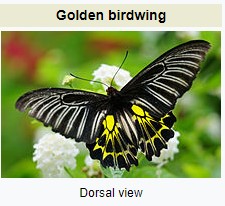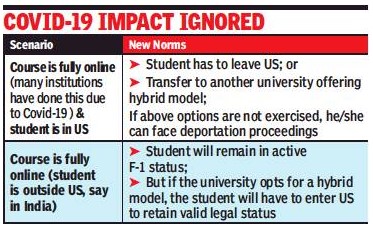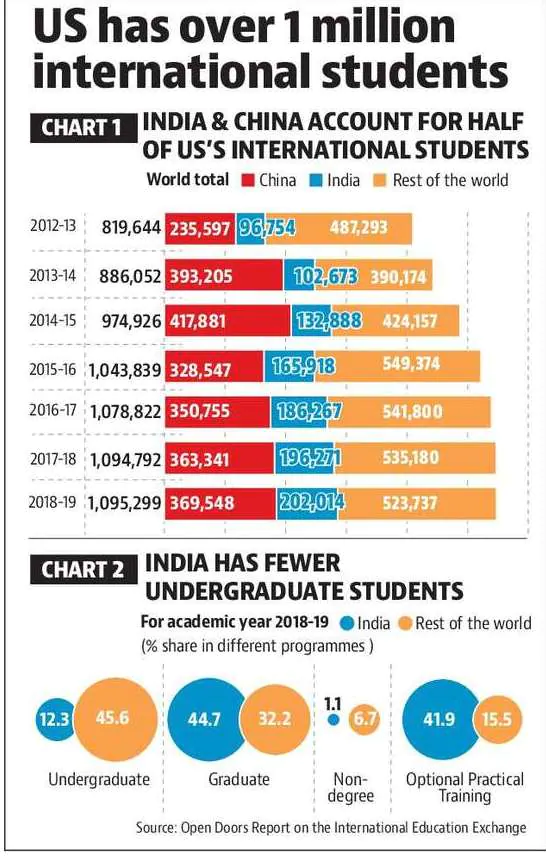Contents
- Golden Birdwing is India’s largest Butterfly
- U.S. Foreign Students revenue and F-1 Visa order
- U.S. position on CAATSA unchanged
- UN report: Climate Change and Disease Transmission, Zoonotic
GOLDEN BIRDWING IS INDIA’S LARGEST BUTTERFLY
Focus: GS-III Environment and Ecology, Prelims
Why in news?
A Himalayan butterfly named Golden Birdwing is India’s largest, a record an unknown specimen had held for 88 years.
Details
- With a wingspan of almost 20 centimeters, the female of the species is marginally larger than the Southern Birdwing (recorded in 1932).
- According to the authors, the only measurement used in the study of Lepidoptera is wingspan — a simple concept with various interpretations of the term.
Lepidopterology, is a branch of entomology concerning the scientific study of moths and the three superfamilies of butterflies. Someone who studies in this field is a lepidopterist.
Golden Birdwing

- Troides aeacus, the golden birdwing, is a large tropical butterfly belonging to the swallowtail family, Papilionidae.
- It is found in northern India, Nepal, Burma, China, Thailand, Laos, Vietnam, Taiwan, Cambodia, peninsular Malaysia and Indonesia.
- It is generally common and not threatened though it is classified as vulnerable.
-Source: The Hindu
U.S. FOREIGN STUDENTS REVENUE AND F-1 VISA ORDER
Focus: GS-II International Relations
Why in news?
Foreign students in the U.S., including thousands of Indians, are left facing the possibility of falling out of valid immigration status following a Department of Homeland Security rule on attending online classes.
Details
- The rule says those F-1 and M-1 (non-academic and vocational students) visa holders planning to take online classes only will not be allowed to remain in the U.S.
- Due to COVID-19, a number of universities are planning to shift all their classes online for the fall semester.
- Active students currently in the United States enrolled in such programs must depart the country or take other measures, such as transferring to a school with in-person instruction to remain in lawful status.

U.S. and Indian Students as a revenue source
- According to a 2019 report, there were over one million international students in the US in the academic year 2018-19.
- India has the second largest share in number of international students in the US after China.
- Chinese and Indian students account for more than half of international students in the US.
- The number of Indian students in the US crossed 200,000 for the first time in 2018-19.
- While India is an important source of international students in the US, the profile of Indian students is different from the rest of the international students in the US.
- More than 80% of Indian students are enrolled in graduate programmes or Optional Practical Training, which allows student visa holders to work for a year.
- Only 12 % of Indian students were enrolled in under graduate programmes in the US. This share is at least 45% for students from countries excluding India.
- According to another report: International students brought $ 41 billion in revenue and supported more than 4 lakh jobs across various sectors in the US.

F-1 Visa
- In the United States, the F visas are a type of non-immigrant student visa that allows foreigners to pursue education (academic studies and/or language training programs) in the United States. F-1 students must maintain a full course of study.
- F-1 visas are only issued in U.S. embassies and consulates outside the United States.
- F-1 students must show that they are able to support themselves during their stay in the U.S., as their opportunities for legal employment are quite limited.
3 types of F Visas
- F-1 visas are for full-time students.
- F-2 visas are for spouses and children of F-1 visa holders — these are technically called “dependents.”
- F-3 visas are for “border commuters” who reside in their country of origin while attending school in the United States.
Recently in News: Click Here to read more about U.S. Pause on H1B Visas
-Source: The Hindu, Hindustan Times
U.S. POSITION ON CAATSA UNCHANGED
Focus: GS-II International Relations
Why in news?
- Despite a change in the ground realities following the deadly clash between India and China along the Line of Actual Control (LAC) last month, the U.S’s message to countries, including India, on sanctions for the purchase of Russian arms has not changed.
- This message was reiterated in the context of India’s planned jet fighter deal with Russia.
Details
- The U.S. urged all of its allies and partners to forgo transactions with Russia that risk triggering sanctions under the Countering America’s Adversaries Through Sanctions Act (CAATSA).
- In the light India’s recent approval of purchase from Russia, the Secretary of State has not made any determination regarding the significance of any transaction involving India.
Countering America’s Adversaries Through Sanctions Act, CAATSA
- The Countering America’s Adversaries Through Sanctions Act, CAATSA is a United States federal law that imposed sanctions on Iran, North Korea, and Russia.
- The Act empowers the US President to impose at least five of the 12 listed sanctions on persons engaged in a “significant transaction” with Russian defence and intelligence sectors.
- The State Department has notified 39 Russian entities including almost all major Russian defence manufacturing and export companies/entities.
India and CAATSA
- In 2018, India inked an agreement worth more than 5 billion $ with Russia to procure four S-400 Triumf surface-to-air missile defence system, the most powerful missile defence system in the world ignoring the CAATSA act. The U.S. threatened India with sanctions over India’s decision to buy the S-400 missile defense system from Russia.
- Two oil companies ordered crude oil from Iran for November ignoring CAATSA. The United States threatened India with sanctions over India’s decision to buy oil from Iran.
Recently in news: Click Here to read more about the DAC Approval of Purchase of Fighter Jets and more
-Source: The Hindu
UN REPORT: CLIMATE CHANGE AND DISEASE TRANSMISSION, ZOONOTIC
Focus: GS-III Environment and Ecology, Prelims
Why in news?
The United Nation Environment Program (UNEP) and the International Livestock Research Institute (ILRI) report says:
- Climate change can particularly affect diseases transmitted by insects.
- 75 per cent of all emerging infectious diseases are zoonotic.
Details of Climate Change and Transmission of Diseases
- Warmer temperatures can increase the vector population size and distribution, along with the season duration when infectious vector species are present in the environment.
- Erratic weather events have an impact in the transmission of diseases as well. For examples: in Africa, an outbreak of Rift Valley fever, a mosquito-borne zoonotic disease, occurred with higher than average seasonal rainfall.
- The thawing of permafrost in the Arctic and sub-arctic region can significantly transforms soil structures, vegetation and habitats.
- The thawing of permafrost in the Arctic and sub-arctic region can significantly transforms soil structures, vegetation and habitats.
Details of Increased Zoonotic Disease
- About 60 per cent of known infectious diseases in humans and 75 per cent of all emerging infectious diseases are zoonotic.
- Zoonosis or zoonotic disease is a disease that has passed into the human population from an animal source directly or through an intermediary species.
- Zoonotic infections can be bacterial, viral, or parasitic in nature, with animals playing a vital role in maintaining such infections.
- Examples of zoonoses include HIV-AIDS, Ebola, Lyme Disease, malaria, rabies, West Nile fever, and the current novel coronavirus disease (COVID-19) disease.
Anthropogenic factors and Zoonotic Diseases
The report identified seven anthropogenic driving factors leading to the emergence of zoonotic diseases:
- Increased demand for animal protein;
- Rise in intense and unsustainable farming;
- The increased use and exploitation of wildlife;
- Unsustainable utilisation of natural resources;
- Travel and transportation
- Changes in food supply chains
- The climate change crisis.
The growing demand for animal-derived food has encouraged the intensification and industrialisation of animal production, wherein a large number of genetically similar animals are bred in for higher productivity and disease resistance.
- Intensive farm settings cause them to be raised in close proximity to each other, in less ideal conditions characterised by limited biosecurity and animal husbandry, poor waste management and use of antimicrobials as substitute for these conditions. This makes them more vulnerable to infections, which can further lead to emergence of zoonotic diseases.
- Loss of forest cover for agricultural purposes such as growing of soy, used as a key constituent of animal feed, is also influencing the emergence of zoonotic diseases by increasing human access to wildlife.
- High use of antimicrobials in such farm settings is also contributing to the burden of antimicrobial resistance (AMR), which itself is a chronic pandemic of high cumulative damage threating public global public health.
- The increased use and exploitation of wildlife can bring humans in closer contact with wild animals, thus increasing the risk of zoonotic disease emergence.
Recommendations based on One Health Approach
The report made ten recommendations based on the One Health approach that could aid a coordinated multi-sectoral response to future pandemics. These included:
- Raising awareness of zoonotic diseases;
- Investing in interdisciplinary approaches, including One Health;
- Expanding scientific enquiry into zoonotic diseases;
- Improving cost-benefit analyses of interventions to include full-cost accounting of societal impacts of disease;
- Strengthening monitoring and regulation practices associated with zoonotic diseases, including food systems;
- Incentivising sustainable land management practices and developing alternatives for food security and livelihoods that do not rely on the destruction of habitats and biodiversity;
- Improving biosecurity and control, identifying key drivers of emerging diseases in animal husbandry and encouraging proven management and zoonotic disease control measures;
- Supporting the sustainable management of landscapes and seascapes that enhance sustainable co-existence of agriculture and wildlife;
- Strengthening capacities among health stakeholders in all countries; and
- Operationalising the One Health approach in land-use and sustainable development planning, implementation and monitoring, among other fields.
July 6, 2020, celebrated as ‘World Zoonoses Day’.
-Source: Hindustan Times





